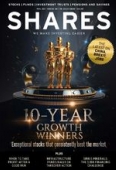Archived article
Please note that tax, investment, pension and ISA rules can change and the information and any views contained in this article may now be inaccurate.
How refinancing debt could unlock more dividends and value for investment trusts

Recent activity at Brunner Investment Trust (BUT) helps shine a light on the expensive debt carried by some investment trusts and how refinancing these borrowings could be a catalyst for trusts to trade on higher valuations and pay out more in dividends to their shareholders.
Unlike traditional funds, investment trusts can borrow money to invest. This is known as gearing and in a rising market it can help to boost returns, although it can work against shareholders when markets fall by magnifying short-term losses.
WHY DO INVESTMENT TRUSTS CARRY DEBT?
The level of gearing varies from trust to trust, but the overall average has stayed fairly level for the last two years or so and is currently 7.2%.
The ability to borrow money can be a useful tool for the manager of a trust. It means, for example, they don’t always have to sell holdings when they find another opportunity to invest in.
A critical point is that the fund manager must be confident they can earn a better return on the additional investments accessed via debt than the cost of borrowing the money.
There are different methods by which a fund manager can look to gear up their portfolio including bank debt, loan stock, debentures, foreign currency loans or preference shares.
Much of the debt taken on by trusts comes in the form of debentures. In corporate finance, a debenture is a medium to long-term debt instrument used to borrow money at a fixed rate of interest.
The long-term nature of much investment trust debt is significant as some trusts secured their borrowings at much higher rates of interest than are available in the market now.
In the 1990s trusts locked in borrowing costs when interest rates were in high single or even double digits.
Given that rates have been historically low for more than a decade, the previous agreements on high rates now look like a mistake. It also raises the prospect that a manager might pursue higher returns at a higher level of risk in order to help meet the costs of borrowing.
COST OF REPAYING EARLIER
Brunner was faced with substantial interest payments on legacy borrowings until 1 June this year when it revealed the early repayment of the last remaining high-cost debt in its portfolio totalling £28m.
There are often penalties for redeeming debt early but by placing a £25m note at a record low rate of 2.85% for 30-year debt and meeting the remaining £14.4m costs (including interest) to repay the outstanding borrowings from bank debt and existing assets, the investment trust was able to reduce its overall interest costs from 7.7% to 2.9% a year.
Looking at the borrowings in question in more detail, the first tranche of £15m was issued in 1993 at an effective interest rate of 9.3%. The second tranche of £13m was assumed from an existing borrower in 1998 at an effective interest rate of 6%.
As Edison analysts Mel Jenner and Sarah Godfrey observe: ‘Coupled with the lower cost of debt, a potentially higher yield could lead to a narrowing in the trust’s discount (to net asset value). Brunner has a distinguished distribution track record, growing dividends for the last 46 consecutive years.’
Brunner currently trades at an 8.9% discount to NAV. Over the past 12 months its widest discount has been 11.3% and the narrowest 5.9%.
Higher interest debt is likely to have a material impact on net asset value. As a reminder NAV is calculated by subtracting a company’s liabilities from its assets.
The level of liabilities will depend on whether the debt is being valued at its nominal value or if the level of interest is being factored in to reflect ‘fair’ value.
Higher interest payments will also mean a company has less cash to pay out to shareholders in dividends.
OTHER TRUSTS WITH EXPENSIVE DEBT
Brunner is not the only trust that has been burdened with expensive debt and we now explore a few more examples which are worth watching closely to see if and when they might shift their borrowings to enjoy a lower level of interest.
One such trust which has already moved to reduce the cost of its long-term borrowing base is JPMorgan Claverhouse (JCH).
In November 2017 the trust, which focuses on UK stocks and has a good track record of paying out income and generating capital returns, agreed to issue £30m fixed rate 25-year unsecured notes at an annualised coupon of 3.22%. The issue will take place at the point its current 7% debenture matures in March 2020.
Managed by a team at Invesco Perpetual, Edinburgh Investment Trust (EDIN) has a £100m debenture which matures in 2022. Issued in 1997 it carries a fairly onerous rate of 7.75%. (TS)
MERCANTILE:
Another trust dealing with relatively high debt
Steered by highly rated manager Guy Anderson, Mercantile Investment Trust (MRC) has a £175m, 6.125% debenture which is repayable in February 2030. The company issued the debt at the beginning of this century at what it felt at the time were ‘attractive rates’ of interest.
Launched in 1884, one of the oldest trusts in existence pays quarterly dividends and aims to grow its dividend at least in line with inflation.
‘We’re looking to generate long term capital growth and the dividend has been on a pretty encouraging trajectory over the last four or five years, as income coming into the portfolio has been growing quite nicely,’ says Anderson.
He says Mercantile has a really exciting investment universe, looking at the FTSE 250 and small caps and it can also invest in stocks listed on AIM. ‘In practical terms, we could be looking at a company that has got a market cap of £50m up to something valued at £4bn or £5bn at the top. We don’t buy companies that are in the FTSE 100, but we have the latitude that when existing holdings are promoted into the FTSE 100, we don’t have to sell them on that point.’
Mercantile’s managers focus on valuation. ‘We look at a range of metrics but the key thing we look at is the cash the business generates because that should be the ultimate arbiter of what it is worth,’ says Anderson, seeking firms with solid fundamentals.
‘We meet about 300 management teams a year – asking them what they think are the prospects for the business and how they allocate capital.’
Anderson wants to know what they’re hoping to achieve and then he will assess what they actually do versus what they say. He is also looking to identify positive change, such as a management-led restructuring, a cyclical turning point or a company with underappreciated growth momentum. (JC)
Important information:
These articles are provided by Shares magazine which is published by AJ Bell Media, a part of AJ Bell. Shares is not written by AJ Bell.
Shares is provided for your general information and use and is not a personal recommendation to invest. It is not intended to be relied upon by you in making or not making any investment decisions. The investments referred to in these articles will not be suitable for all investors. If in doubt please seek appropriate independent financial advice.
Investors acting on the information in these articles do so at their own risk and AJ Bell Media and its staff do not accept liability for losses suffered by investors as a result of their investment decisions.

 magazine
magazine













